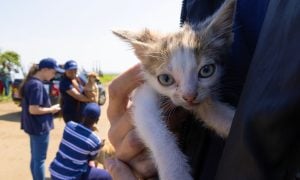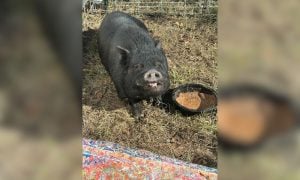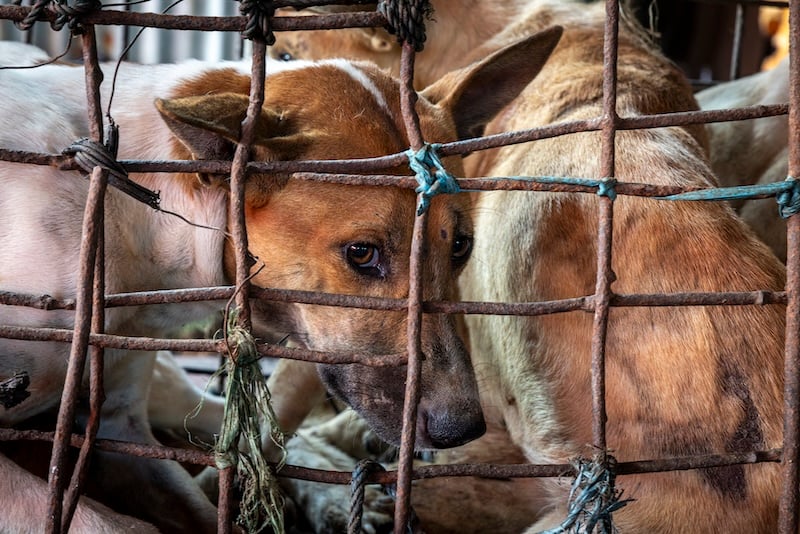In her book Media Monsters: Militarism, Violence, and Cruelty in Children’s Culture, author, mother and former educator Heidi Tilney Kramer confronts the violence so prevalent in TV, movies, video games, music and more that many of us barely notice it.
Kramer points out that, while media violence is widely accepted in our society, it impacts children’s perception of how they should act — and indeed, their actions themselves — perpetuating a culture of cruelty.
It’s not just the media, either, Kramer argues — human actions, right down to the education system itself, are contributing to the problem.
I interviewed Heidi on the book, and the disturbing issues it addresses.
Nina: Can you describe the premise of Media Monsters?
Heidi: Media Monsters attempts to inform citizens of what is being done to children in our name; that is, it points out flaws across institutions in order to fix what we don’t know about. What we don’t know about is what’s in front of us daily: flashing images and sounds which teach militarism, violence, and cruelty.
For example, in education, some – mainly in poor neighborhoods and those of color – are being arrested for minor infractions. Many Americans have no idea this is happening nor how it is affecting dropout rates.
Schools in general have increased prison-like conditions through surveillance and security measures supposedly put in place for the children’s safety. Those in charge are using easily accessible weapons as an excuse for putting more cops in schoolrooms. After Columbine, 10,000 were added to the force supposedly to protect us from another mass shooting. How did that work?
Florida’s Gov. Scott is spending $400 million to make our schools more prison like. How about paying attention to when others are not being treated well by teachers, parents, and perhaps most especially, by fellow students? More often than not, shooters are white boys from intact homes who are mercilessly bullied with no way out. This is often enforced by their teachers. For instance, at Columbine, whoever was in charge of the school newspaper allowed it to print that the young men who took vengeance on their also-mean-spirited classmates were lovers; they weren’t. Let’s look at what the strict gender binary is doing to students. Anyone who strays from the mundane or the popular or the hegemonic is suspect; often, even being nice is suspect.
In what is supposed to be childhood entertainment, we are now raising kids who watch torture scenes repeatedly from young ages. Whether on TV or in film, workers, animals, and the environment are consistently abused. In the book, I did an analysis of “The Big Bang Theory” and found so many anti-animal references, its writers should be chastised. Laughing at suffering is not cool. Many Pixar films – among them, Monsters, Inc., The Incredibles, and Toy Story 3 – include R rated themes and scenes in their purported G and PG movies. The Motion Picture Association of America is a censorship bureau in respect to alternative sexualities, alternative substances, and alternative language, but they seem not to notice/choose not to comment on mainstream excessive violence.
Our society’s rulers need to keep stirring the pot in order to get recruits; in fact, they want nothing more than video games where addicted players get the rush of real combat missions, than films with gun violence and bullying so that’s mimicked in real life crimes – why else is there now more gun violence in PG films than R? If you’re making a living from war like we are, you want teen boys to revel in violence. That’s who’s being recruited at military gaming facilities everywhere, that’s who’s being recruited by police after their humanity has been ripped from them overseas when they’re forced to kill children, then come back home and attempt to be normal.
And in what ways does this happen? One look through our real history will tell you. Due to a need for more hired, though barely paid, killers, the US figured out a great number of ways to brainwash citizens through media, entertainment, the education system, sports, etc. But more than that, those scientists and psychologists and other evil priests devoted themselves to undoing the spirit. There are times one wishes there is a hell but I guess that’s part of the same wrongness. There are certain beings which should be held sacred, such as all of them. Lt. Col. Dave Grossman explains in On Killing: The Psychological Cost of Learning to Kill in War and Society: Using conditioning techniques, the military knows how to make us killers and those techniques are spilling into society as they’re being used on younger and younger souls.
Kids are becoming more militaristic because they’re trained how to use weapons on Xbox. So, after hearing so many fellow parents complain when I worked as a teacher at an elementary school, it seemed as if I should document the many problems facing the latest – and maybe the last – generation.
There are now terribly realistic video games where players can join U.S. soldiers in a 2007 Iraq surge to kill Osama bin Laden or, for more bloody carnage, there’s Animal Planet’s “I, Predator,” where one can embody a cheetah killing an antelope.
N: What inspired you to write this book?
H: In addition to feeling the frustration of fellow educators and parents, I personally felt the weight of big business on my family. This went beyond a general awareness of marketing pressure (“Why can’t we find a lunchbox for school which doesn’t promote a mean spirited TV show?”) to a sick feeling in the pits our of stomachs as my son and I agonized over Boo in the Monsters, Inc. torture chair (“Woah, this G-rated film shows a toddler tormented at the hands of the state/corporate control”). Nicely done, Pixar.
These films were always pedagogical, as Henry Giroux explains, mainly teaching a white, classist, sexist, anti-non-human, nature-dominating perspective, but you have gone from teaching children how best to behave in order to avoid condemnation from mainstream, hypnotized society, to instructing them as to what frightening weaponry and technique they might expect in their future. If that seems unlikely, readers may wish to spend time investigating how institutions, not least of which the institution of media, have and do use their power to control opinion. Scripts from many major TV shows and films are, for the moment anyway, available online. As an exercise, read the words and identify when a character is made to appear gay and is teased or when someone is laughed at for being kind to an animal. It is why others feel free to chastise us for kindness, including toward fellow creatures. I call it killing the sacred, meaning a twisting of all that is good.
N: You’re also an advocate for animal rights. Do you believe children’s culture also affects the ways kids view cruelty to animals?
H: Children often instinctively know how to treat human and non-human entities/friends, yet it is helpful if they are offered a guiding hand. We do this with helping kids learn to brush their teeth and we also need to teach them to be kind to fellow creatures. They must learn the many ways in which they can assist our living planet.
My family and I moved to Florida when I was eight-years old and no one has ever enjoyed the shore and orange trees more than I! I still remember the seemingly illogical reaction I had when I ran down to the water and turned around to see a zillion crabs had surfaced from the vibration I’d just caused: shock and glee! I was always climbing or running or skipping or sitting under or in a tree. Kids need that. That’s really a thing!
Last Child in the Woods: Saving Our Children From Nature-Deficit Disorder, by Richard Louv, explains that being in nature is essential for healthy development. How I loved every butterfly which fluttered by! I still do. Childhood, then, is when opinions and habits concerning the world form. If a person is not introduced to how to be empathetic and compassionate – even little actions like encouraging a child when they’d like to put a dish of water out for the neighborhood creatures make a huge difference – they may never incorporate that into their world view. They may never know it is a good thing to help fellow friends.
But there is a huge problem; a disconnect, if you will, between what we know in our hearts to be right and the messages which make us question ourselves. We are constantly told that animals and other creatures are beneath us. We are periodically laughed at if we make it clear to others that we must depart so we can get home to feed our animals. No one discusses the agony put upon the animal our new shoes were created from without facing at least a modicum of ridicule.
One of the Hayao Miyazaki films illustrates this from a child’s perspective beautifully: Nausicaä of the Valley of the Wind shows a child who has tried to rescue and hide a baby creature but is discovered by her father, who tells her it isn’t possible for us to be friends with them. We constantly get that message from a young age, whether from family and friends or from cartoons: you’re a fool if you care, perhaps most especially if you care about the other-than-human.
Unfortunately, that is one of few depictions of a child being kind to animals in children’s films. Think of the screen version of The Indian in the Cupboard. A kid kicks a hamster ball – with hamster inside – down the stairs. Needless to say, this could easily kill, wound, or cause brain damage to one so frail; also needless to say, this was Hollywood’s choice and was not in the original book. Or think of the many salt jokes in relation to snails and slugs in Turbo – yet another place kids learn cruelty toward animals. There are now only 5 – soon to be 4 – media companies which control over 90% of what we see and hear. The agenda they’ve created – Disney/Pixar included – is one of cruelty.
How could what adults do (especially those in key roles) NOT affect the children around them? Kids who see family members, authority figures OR favorite characters committing unkind acts may come to think of said behavior as suitable or follow suit, unfortunately. It works the same for adults. This supposedly cool culture we’ve created is harming us.
When I was an elementary school teacher, there were a few girls who were bullying the other kids. I started a classroom project called the Kindness Tree. The idea is that when a student witnesses another doing a kindness, the observer writes about it on a piece of paper and hangs it on a small (or large!) metal frame classroom tree. An outside tree could be planted at the same time expressing kindness to the Earth to help fellow creatures. Suddenly the kids were not just trying to spot kindnesses but to commit them so others might take notice. It became more cool than the mean coolness which had been in fashion in that class. We need more ideas like that: build a bee hotel day, or let’s exchange flowers and see what butterflies come by — or why don’t we grow heirloom fruit trees in our backyards to feed the multitudes of homeless our society is increasingly creating?
Society charges us with the (student-loan-like-you’ll-never-pay-this-back-but-you-have-to-do-it-anyway) dichotomy, placed upon us always in all ways: human versus non-human, men versus women, gay versus straight, etc. etc. There seems a risk impassible at trying, there seems too much a winless road, for many are called and few follow into the gleeful innocence of a pure heart, one which seeks justice. Mahatma Gandhi said it best: “The greatness of a nation can be judged by the way its animals are treated.” With our animal experimentation, we are, perhaps, the greatest afflicters of pain on animals, certainly by scale if no other measure. Hundreds of thousands of animals are maimed and killed by our military and its affiliates at universities and at private facilities across the land. We should hang our heads in shame.
N: Overall, how much influence do you think the media has over children’s thoughts and actions?
H: The media has much more influence over us – and, in particular, children – than is generally recognized. We know that mimicry is a part of how we learn. We know that adults are more likely to maim/kill/be less empathetic when they’ve been watching slasher films and highly publicized boxing matches. We know that crimes are beginning to mirror electronic scenarios. Children are especially vulnerable since they can only easily distinguish between reality and fiction from the age of seven onward. We have a virtual epidemic of minors who have become as addicted to video games as the ’80s disco generation was to cocaine. It got so bad in South Korea – they beat the US in advancing digital media and bearing its fallout – that their government set up free detox camps for kids so they can detox from the Internet and, most especially, video game play and learn how to study and say hello to their parents now and again. Our kids are learning to be mean from media just like the adults in their lives, sadly. And with successive generations comes meaner content. Where will it end? And if you’re wondering why no one is talking about this epidemic on our youth, ask yourself why.
N: What can adults do to counter negative messages from media?
H: There are so many ways to help, from talking with the children in our lives about what’s wrong with the problematic film you are watching to writing letters to these companies to learning how to deconstruct the messages out there. Please look up Sut Jhally’s work at Media Education Foundation and Project Censored, one of few places with REAL news articles AND classes to help people de-code the media they’re ingesting. That’s very important.
N: Any other thoughts or stories you’d like to share?
H: We’ve started a petition for John Lasster asking him to stop putting excessive violence, cruelty and militarism in G and PG rated films. Click here to sign it now.
As you know, we have to be brave about doing what we believe is right. Remember that we have our entire lives to think back on what we do today. How would we like to be remembered? More, we have to be willing to defend those in need of defense even if there is no one by our side. I was lucky that my parents had a great respect for the non-human. I remember my dad pulling over to help stray dogs and my mother writing thousands of letters on behalf of animal and child welfare. Never do something you feel is wrong, even – or maybe especially – if it is expected. Rather than think about who you are counting on and your expectations of them; think instead of who is counting on you. We are duty bound to the higher collective to protect what was on this land before humans. We owe it to the mother, Earth. We owe it to the waves and to the skies. We are responsible for taking care of each other, the benefactors and guardians of all that came before and deserves to continue with or without us.
Media Monsters: Militarism, Violence, and Cruelty in Children’s Culture is available now on Amazon. Click here to purchase a copy.







